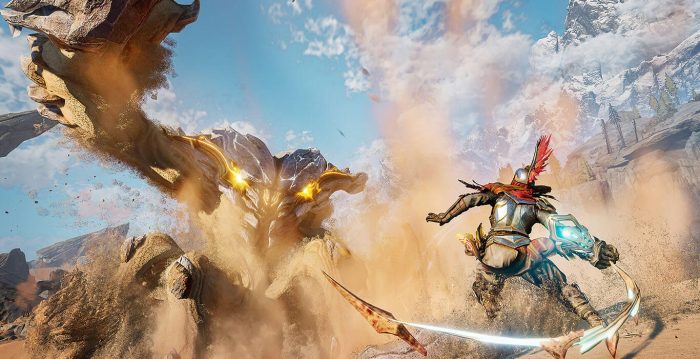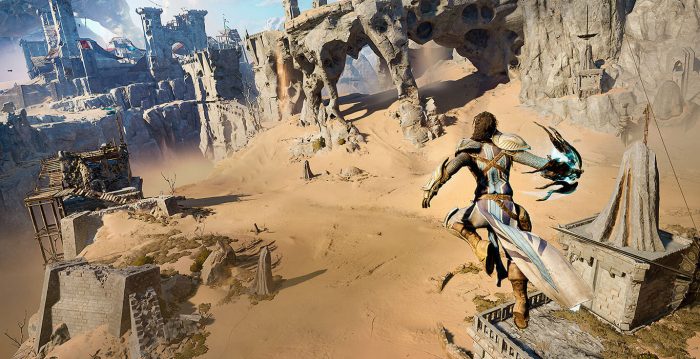Open world gaming fusion that focuses on sandy exploration, but often gets engulfed with repetition
Over the years I’ve noticed a particularly annoying trend in the industry where players get so attached to a particular game that they become traditionalists and overly complacent, seeing other games that try to do something similar as being derivative. They forget that derivation isn’t necessarily a negative, but can actually lead to new experiences with their own identities.
Some of my favorite games have come from taking multiple games and combining them into something unique. The Darksiders franchise has always been a cross between traditional 3D Zelda and a spectacle fighter, but streamlined in such a way and with a unique setting that it retains an identity of its own. Immortals: Fenyx Rising was another favorite of mine, streamlining Breath of the Wild and Assassin’s Creed, but with a colorful and whimsical take on Greek mythology, making it stand out as well.
Back in August of last year, Deck13 released Atlas Fallen, which caught my eye for similar reasons to the games mentioned above: it combined elements of different games that had always intrigued me, but due to certain aspects I couldn’t get into, but now being fused into one that I could. In the case of Atlas Fallen, it took most from Monster Hunter, with the core gameplay loop being taking down large monsters by destroying parts of their body.
I could never get into Monster Hunter. There was just too much going on for me to keep track of, and considering that I’m not much for cooperative play I wasn’t able to enjoy what I could see were objectively good games. But they weren’t for me. Atlas Fallen and its massive Reign of Sand update, on the other hand, take much of those ideas (while sprinkling in a few others) all the while keeping it simple enough for people like me.
We start the game being able to create a character avatar, but we are left Nameless. The Unnamed are the lowest class of people in the world of Atlas Fallen, shunned and made into slaves. We discover a gauntlet holding the powers of a god, his consciousness enslaved within. Together we set forth to find a reclusive order of knights, so that we might destroy an ancient tyrant god and give freedom to the Unnamed.

While the game is open world, it’s not one continuous map. It’s instead broken up into fairly expansive areas we’ll come to in linear fashion, but each having a distinct thematic flair and bevy of optional content that it feels like we’re playing in a smaller, but highly detailed and expertly crafted sandbox. One of the main regions we get to explore is completely underground, a lost civilization sunken in the sand; it made me think of what Prince of Persia could look like on a large scale.
Sand is the central motif in Atlas Fallen; it’s everywhere we go. It encroaches upon the world due to the god Thelos, his towers spreading corruption and causing the creation of monsters known as Wraiths. Even the wraiths are made up of sand particulates.
Combat in the game is sort of an oxymoron. It’s an Action-RPG where we are given quite the array of options for character builds. With the gauntlet we are able to equip Essence Stones, which are either combat moves or passive abilities. They are even color-coded into categories so having five of one kind gives us a bonus trait. If we have certain amounts with specific armor we’ll get even more bonuses, and each armor has unique stats and traits of their own. There’s even the three weapons we still have to take into account, and air dashes and parries that freeze enemies and a momentum gauge that has us cause more damage the higher it is, but at the expense of our defense.

But does any of that really matter when every encounter feels the same? I’d estimate that about a third of the way into the game was when this feeling started gnawing at me, and then at the halfway mark I theorycrafted a build that brought me to the end of the game. The complexity in build crafting destroyed any sense of challenge, and turning up the difficulty didn’t make sense because the enemies were already overly high in health. I didn’t even realize that a particular sidequest I was undertaking throughout the game was DLC because it was so easy, and didn’t help alleviate the sense of grind.
The story itself also became a chore early on, but this was almost entirely due to the dialogue and voice acting. Both the performances *and* audio mixing are garbage. However, the worldbuilding pushing me to explore the nooks and crannies really brought to light the best part of the game: exploration.
Throughout the game we get to upgrade our gauntlet in such a way that lets us dash further in the air, lift chests and raise structures buried in the sand, and reveal secret passages or break down barriers. It becomes like an open world Metroidvania, with a lot to discover. It got to me to the end, this desire to explore the world.
I just don’t think it’ll get anyone else to.
This review is based on a copy purchased by the reviewer. It was played on the PS5.


No Comments